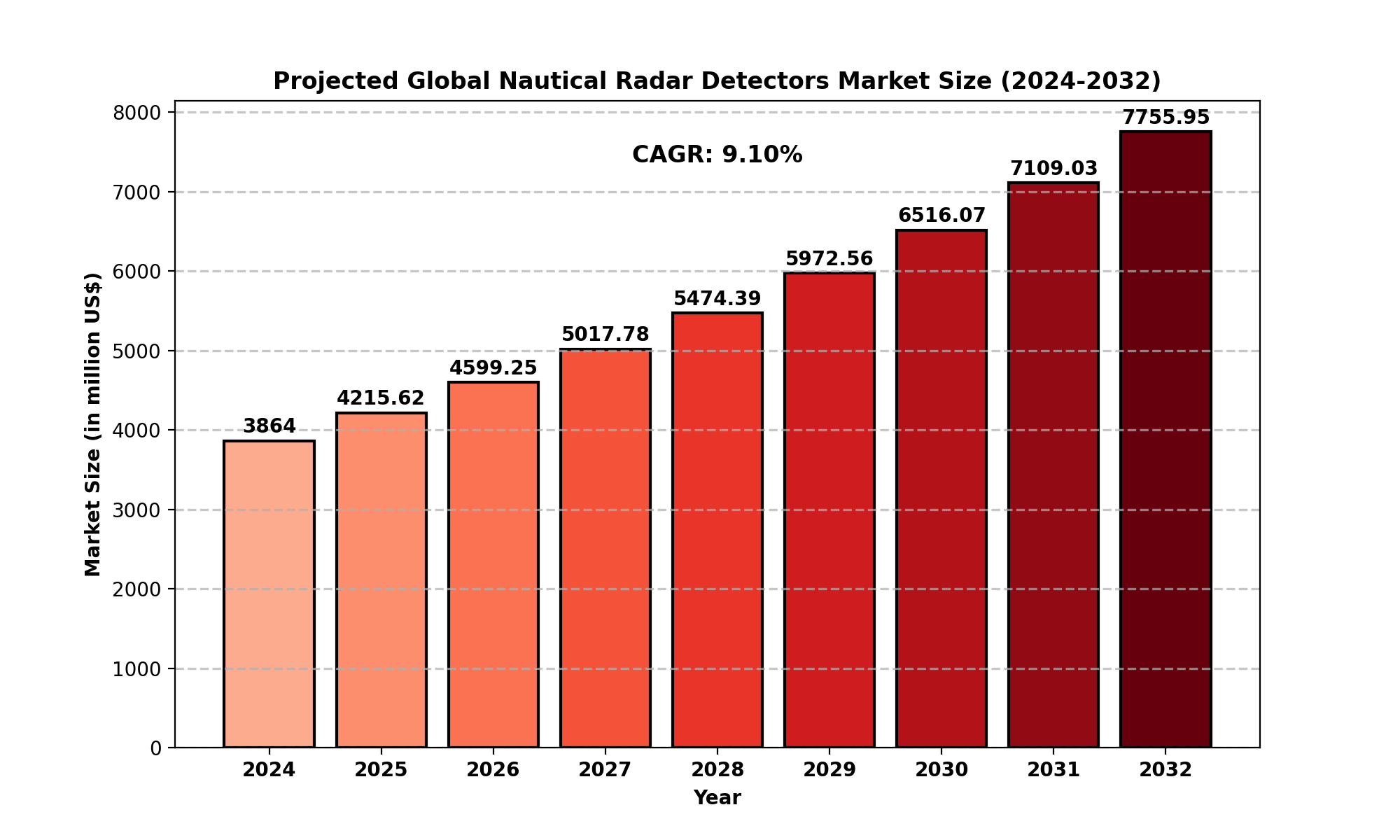TOP CATEGORY: Chemicals & Materials | Life Sciences | Banking & Finance | ICT Media

Download Report PDF Instantly
Report overview
Nautical radar detectors are essential maritime navigation tools designed to enhance safety, efficiency, and situational awareness for vessels operating in diverse marine environments. These devices emit electromagnetic waves to identify the range, angle, or velocity of stationary and moving targets, aiding in collision avoidance, ship positioning, and narrow channel navigation. Nautical radar detectors are critical for maritime navigation under challenging weather conditions and poor visibility, ensuring vessels detect obstacles and prevent accidents effectively.
The global nautical radar detectors market has demonstrated substantial growth over recent years. In 2024, the market size was estimated at USD 3,864 million, with projections indicating it will reach USD 7,755.95 million by 2032, growing at a robust CAGR of 9.10% during the forecast period.
North America, a key regional market, accounted for USD 1,170.04 million in 2024, with a CAGR of 7.80% expected between 2025 and 2032.
This growth can be attributed to increasing investments in maritime safety, advancements in radar technology, and heightened demand for efficient navigation systems across commercial and military applications.


Drivers
Technological Advancements: Innovations in radar technology, such as enhanced detection accuracy, multi-target tracking, and integration with other maritime systems, are driving market growth.
Increased Maritime Trade: Growing global maritime trade has heightened the need for efficient navigation and collision avoidance systems, boosting demand for nautical radar detectors.
Rising Safety Regulations: Stringent international regulations for maritime safety, such as those from the International Maritime Organization (IMO), are compelling the adoption of advanced radar systems.
Restraints
High Costs: The high initial investment and maintenance costs of advanced radar systems can be a barrier for small and medium-sized vessel operators.
Technological Complexity: The operation of sophisticated radar detectors requires skilled personnel, posing a challenge in regions with limited technical expertise.
Opportunities
Emerging Markets: Rapidly growing maritime industries in Asia-Pacific and Latin America present untapped opportunities for market expansion.
Integration with AI and IoT: Incorporating artificial intelligence and IoT capabilities into radar systems can enhance functionality, creating new growth avenues.
Challenges
Environmental Factors: Adverse environmental conditions, such as heavy rain or sea clutter, can affect radar performance and reliability.
Cybersecurity Concerns: As radar systems become increasingly connected, they are more susceptible to cyber threats, requiring robust security measures.
North America
North America remains a dominant player in the nautical radar detectors market, driven by its robust maritime trade, extensive coastline, and significant investments in defense and navigation technologies. The U.S. leads the region with advanced military applications and strong regulatory support.
Europe
Europe’s market is propelled by its thriving shipping industry, high adoption of advanced navigation systems, and strong focus on environmental sustainability. Countries like Germany, the UK, and France are key contributors.
Asia-Pacific
Asia-Pacific is the fastest-growing market, fueled by increasing maritime trade, expanding shipbuilding industries, and growing investments in navigation safety in countries like China, Japan, and South Korea.
South America and Middle East & Africa
These regions exhibit moderate growth, supported by increasing awareness of maritime safety and investments in port infrastructure. However, challenges like limited technological adoption and high costs remain.
The nautical radar detectors market is highly competitive, with key players focusing on technological innovation, product diversification, and strategic collaborations. Major companies include:
Furuno Electric
Lockheed Martin
Northrop Grumman
Raytheon
Saab
Japan Radio
BAE Systems
Garmin
Navico Group
FLIR Systems
These companies are actively enhancing their market positions through R&D investments, partnerships, and acquisitions.
Merchant Marine: Dominates the market due to the extensive use of radar systems in commercial shipping for navigation and collision avoidance.
Fishing Vessels: Increasingly adopting radar systems for locating fish schools and ensuring safe navigation in crowded fishing zones.
Yacht: Luxury and recreational vessels are driving demand for compact, high-performance radar systems.
Military: Advanced radar systems play a crucial role in defense applications, including surveillance, threat detection, and navigation.
X Band Radars: Widely used for their high resolution and short-range detection capabilities, particularly in collision avoidance and port navigation.
S Band Radars: Preferred for long-range detection, especially in adverse weather conditions.
Furuno Electric
Lockheed Martin
Northrop Grumman
Raytheon
Saab
Japan Radio
BAE Systems
Garmin
Navico Group
FLIR Systems
North America: USA, Canada, Mexico
Europe: Germany, UK, France, Russia, Italy, Rest of Europe
Asia-Pacific: China, Japan, South Korea, India, Southeast Asia, Rest of Asia-Pacific
South America: Brazil, Argentina, Colombia, Rest of South America
Middle East and Africa: Saudi Arabia, UAE, Egypt, Nigeria, South Africa, Rest of MEA
1. What is the current market size of the nautical radar detectors market?
2. Which are the key companies operating in the nautical radar detectors market?
3. What are the key growth drivers in the nautical radar detectors market?
4. Which regions dominate the nautical radar detectors market?
5. What are the emerging trends in the nautical radar detectors market?